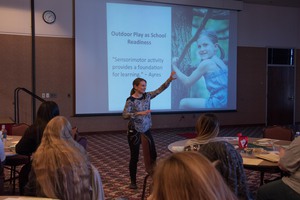Pediatric occupational therapist recommends more outdoor play for young children

CHADRON – Pediatric occupational therapist Angela Hanscom addressed more than 200 childcare providers and Chadron State College students Saturday at the Student Center. Hanscom’s keynote address focused on the physical and mental health benefits of outdoor play for young children.
Hanscom is the founder of TimberNook, a three-week outdoor camp for children near her home in New Hampshire. She has licensed the TimberNook curriculum in several countries around the world. Her article, “Why Kids Fidget” was the most viewed article in Washington Post in 2014 and led to her Johnson & Johnson TED Talk. She has also written a book about the need for outdoor play, “Balanced and Barefoot.”
She said there is an alarming increase in children’s health issues, including increased aggression, depression and anxiety, decreased attention spans, lack of emotional regulation, running into walls, falling down and falling out of chairs.
“We’re seeing more issues as kids get separated from outdoor play by electronics, travel for sports and heavy homework loads. The outdoors is the ultimate sensory experience. The power it has on development is huge,” she said. “The best learning environment is one in which you are calm and alert. That’s nature.”
Restricting children’s movements by requiring them to sit in classrooms for hours each day is at the core of the problem, according to Hanscom.
“Movement is vital to a healthy vestibular (inner ear/balance) system. It helps their eyes scan which is needed for reading and writing. Also, bird sound can help them with spatial awareness. We need to take a step back from treatment mode and do prevention. Kids need to dig in the dirt, go upside down, climb trees and climb rocks for hours and hours,” she said.
Short recess times don’t allow time for children to create games using their imaginations and excessive playground safety rules that ban spinning on swings or swinging on stomachs limit opportunities for children to develop balance, according to Hanscom.
Most playground equipment can mastered by age 5 so it is being used inappropriately by children who are seeking a challenge, Hanscom said.
One TimberNook activity brings the “Three Little Pigs” story to life with children building houses of bricks, sticks and straw.
“Heavy work helps strengthen their joints and challenge their senses. Using actual adult items motivates, inspires and empowers them. You’re just there, at a distance, for safety. You don’t have to entertain or direct them,” she said. “Employers are looking for creativity so we need to allow children to initiate their own ideas.”
She encouraged care providers to provide wagons and wheelbarrows to move heavy objects and each other. Opportunities to pull, push and hang from tree limbs provide resistance for proper joint and muscle development, she said.
Hanscom shared cooperative play scenarios such as hot chocolate shop and car wash that give children opportunities for sensory, motor and cognitive skill development including coordination, executive function, decision making, problem solving, rules making, creating ideas, sequencing, learning cause and effect, competition, cooperation, leadership and negotiation.
“A therapist visiting the camp said, ‘One week at TimberNook is like six months of therapy.’ The key is children need lots of time and space,” she said. “Start early. Toddlers need to get use to the feel of wind, sand and grass before the develop aversions to these natural things.”
Category: Campus Events, Campus News


